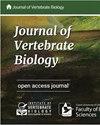Diet of the grey wolf Canis lupus in Roztocze and Solska Forest, south-east Poland
IF 1.5
4区 生物学
Q2 ZOOLOGY
引用次数: 3
Abstract
Abstract. The diet composition and prey selection of grey wolves (Canis lupus) inhabiting the Roztocze and Solska Forest (south-east Poland) was studied based on an analysis of scats collected in 2001-2002 (n = 84) and 2017-2020 (n = 302). In both periods, wolves preyed mainly on wild ungulates (96.5-96.7% of consumed biomass). Roe deer (Capreolus capreolus) was the most critical wolf prey accounting for 57.8% of consumed biomass in 2001-2002 and 49.2% and 2017-2020, but wolves positively select only wild boar (Jacob's selectivity index D = 0.213 in 2001-2002 and 0.710 in 2017-2020) and fallow deer (D = 0.588 only in 2017-2020). The largest species – moose Alces alces and red deer Cervus elaphus – were consumed less than expected from their share in the ungulate community. Predation on medium-sized wild mammals and domestic animals was low, 0.8-2.2% and 1.1-2.7% of the biomass consumed, respectively. The breadth of the wolf diet was very narrow and identical in both study periods (B = 1.07), while the similarity of diet composition was high (α = 0.999). This study indicated the stability of the wolf diet over two decades and the importance of wild boar as a food source for this carnivore.波兰东南部Roztocze和Solska森林中灰狼犬狼疮的饮食
摘要根据对2001-2002年(n=84)和2017-2020年(n=302)收集的粪便的分析,研究了居住在Roztocze和Solska森林(波兰东南部)的灰狼(Canis lupus)的饮食组成和猎物选择。在这两个时期,狼主要捕食野生有蹄类动物(占消耗生物量的96.5-96.7%)。Roe deer(Capreolus Capreolus)是最重要的狼猎物,在2001-2002年占消耗生物量的57.8%,在2017-2020年占49.2%,但狼只积极选择野猪(2001-2002年雅各布选择性指数D=0.213,2017-2020年为0.710)和休耕鹿(2017-2020年仅D=0.588)。最大的物种——驼鹿Alces Alces和马鹿Cervus elaphus——在有蹄类动物群落中的消耗量低于预期。对中型野生哺乳动物和家畜的捕食量较低,分别占消耗生物量的0.8-2.2%和1.1-2.7%。在两个研究期间,狼的饮食范围非常窄且相同(B=1.07),而饮食组成的相似性很高(α=0.999)。这项研究表明了狼饮食在20年中的稳定性,以及野猪作为这种食肉动物食物来源的重要性。
本文章由计算机程序翻译,如有差异,请以英文原文为准。
求助全文
约1分钟内获得全文
求助全文

 求助内容:
求助内容: 应助结果提醒方式:
应助结果提醒方式:


